The Voynich Manuscript: Leonardo da Vinci’s first codex?
Abstract: The surprisingly close similarity between the Voynich Manuscript’s and Leonardo da Vinci’s left-handed, non-cursive humanist minuscule script, hatching and knot drawings, even left and right margins, phonetic spelling, lack of capital letters and punctuation, orthography, subject matter and birthday, indicate that Leonardo may be the author of the VM.
“It is easier to resist the beginning than the end”
— Leonardo da Vinci
Introduction: An article in an old copy of Horizon magazine, (1958-1989), was my original introduction to the Voynich Manuscript. My immediate reaction was the similarity of its script to that found in the notebooks of Leonardo da Vinci. Later I learned that Robert S. Brumbaugh’s son and others also noted this similarity.(i) The VM was probably Leonardo’s first notebook, written when he was a boy, on pages of calf parchment that were later assembled into the book known today as the Voynich Manuscript. The parchment may have come from Italy. According to the most widely accepted explanation, Latin Italia may derive from Oscan víteliú, meaning ‘[land] of young cattle’ c.f. Lat vitulus, calf.(ii) Carbon 14 dating of four of its pages show that the parchment came from calves that died during the first half of the 15th century. This analysis only dates the parchment, not the drawings and script, making it plausible for Leonardo, who was born in 1452, to be the author of the VM.(iii)
Although I spent many hours reading J.P. Richter’s, The Notebooks of Leonardo da Vinci, it was only recently that I read the preface to his first volume. Richter describes Leonardo’s many unique orthographical peculiarities, the same peculiarities I observed while decoding the 111 plant names in the botanical section of the VM. Reading the preface to Richter’s notebooks was an ‘eureka’ moment, like that attributed to Archimedes, when he is purported to have shouted ‘eureka,’ (I have found it) as he ran naked through the streets of Athens, after discovering Archimedes Principle. As you finish reading this article, think about Leonardo da Vinci’s quote, ‘It is easier to resist the beginning than the end’ and whether as a result of reading the following evidence, you agree that Leonardo da Vinci wrote the Voynich Manuscript.
Evidence: Analogous to a Venn diagram, the following examples illustrate the overlap I have observed between the Notebooks of Leonardo da Vinci and the Voynich Manuscript:
- Both authors had very similar script.
- Both authors wrote with their left hand.
- Both authors used non-cursive humanist minuscule script.
- Both authors’ illustrations show unusual drafting skills.
- Both authors used left-handed hatching in their illustrations.
- Both authors’ script had even right and left hand margins.
- Both authors used Dante’s Italian dialect and alphabet.
- Both authors failed to use capital letters, punctuation, or paragraphs.
- Both authors spelt many words phonetically.
- Both authors combined two or more short words into one longer word.
- Both authors split longer words into two or more short words.
- The writings of both authors represent an ‘encyclopedic work on natural philosophy’.
- Both authors had the same birthday.
Both authors had similar script: Some years ago Tania Ocampo, who also noted the similarity between Leonardo’s and the VM’s script, sent me an early example of Leonardo’s handwriting. A comparison of a segment of this script and script from Folio 87r is shown in Plate 1.(iv) Extended loops decorate both scripts and although the one is in mirror image writing and the other uses its own unique alphabet and replaces some letters with symbols, the similarities are remarkable, so much so that when I first saw the Leonardo segment that Tania had sent, I ignored it, thinking that it was a paragraph from the VM. Thankfully I took another look and realized my mistake. As Leonardo matured, his writing became less ornate and he ceased making unnecessary loops and curlicues so prevalent in the VM’s script. Additional evidence is provided by Table 1, showing that many of the VM’s letters and symbols are similar to letters and numbers used by Leonardo.
| VM’s letters & symbols |  |
 |
 |
 |
 |
 |
 |
 |
 |
| Leonardo letters & numbers* |  |
 |
 |
 |
 |
 |
 |
 |
 |
*The mirror image of Leonardo’s letters and numbers are used in Table 1.
Left-handed writing: Leonardo wrote from right to left with his left hand using mirror image writing. Vasari observed with reference to Leonardo’s writing: ‘he wrote backwards, in crude characters, and with the left hand, so that anyone who is not practiced in reading them, cannot understand them.’ Occasionally Leonardo wrote from ‘left to right in the normal way,’ but only when he was writing something intended for other people to read.(v) The VM is written from left to right causing investigators to assume that its author was right handed. In my article, The Voynich Manuscript’s Script and Code,(vi) I show by examining the variations in density of the ink, that when some individual letters were formed, they were written from right to left.
Table 2 indicates that the VM’s author wrote using his left hand, perhaps turning the parchment 90 degrees when he wrote. Left-handed writers were very unusual in the 15th century. Small children were trained first to eat and later, if they were educated, to write using their right hand.
| Letter | Left-handed script | Right-handed script(vii) |
 | Written from right to left. Backhanded slope indicates lefty. | Written from left to right. |
 | Written clockwise. | Written counter clockwise. |
 | Written from bottom right to upper left. | Written from left to right. |
 | Written from the bottom. Back-handed slope indicates lefty.(viii) | Written from the top down. |
 | Written from the bottom. | Written from the top. |
 | Written as arrow indicates. | Written from the top down. |
Humanist minuscule script: Leonardo used humanist minuscule script, a form of handwriting that originated in Italy at the beginning of the 15th century. However he failed to connect individual letters, i.e. his writing was not cursive. 15th century educated Italians wrote using cursive humanistic script. The VM’s author also used unconnected humanist minuscule script.
Plate 1 |
|
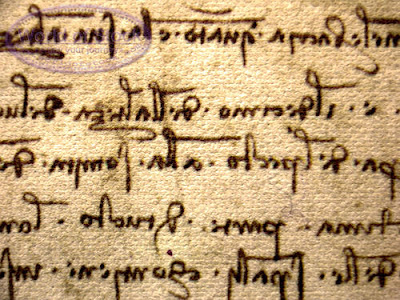 |
 |
| Sample of Leonardo da Vinci's handwriting | Voynich Manuscript folio 87r segment |
Drafting skills: Leonardo was an extremely accomplished draftsman. One example is the knot drawings Leonardo made in Milan in the mid 1490s for Academia Leonardi Vici. These drawings are very similar to the knot drawing in the V.M, folio 86r4.(ix) The astrological and astronomical drawings also show drafting ability with their many perfect circles of words with unform letters and without any apparent errors. Many scribes today would have difficulty duplicating them even with modern drafting equipment.
Plate 2 |
|
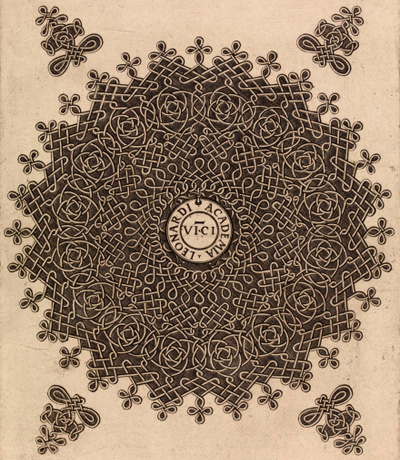 |
 |
| Vinci Academia | Voynich Manuscript folio 86r4 |
Hatching: Leonardo not only wrote with his left hand, he also used it for drawing. Richter points out that ‘wherever shading (hatching) is introduced, the strokes lie from left to right (downwards) as they would be drawn with the left hand.’(x) Leonardo began his hatching stroke from the lower right, making a slight tick as he moved the pen or stylus up and to the left. He continued drawing similar lines as his pen moved from right to left across the paper, thus preventing his hand from smudging the ink. A right-handed individual instinctively begins a hatching stroke at the lower left of the area and moves up to the right. Similar lines are repeated from left to right. I checked the VM for examples of hatching and found hatching strokes in folios 84r and 86. In both examples the starting point of the hatching stroke may be determined by the point on the line with the greatest accumulation of ink. Each hatching stroke begins with a small tick at the lower right of the area to be shaded and moves up to the left. The lines continue from right to left. This is consistent with hatching lines made by an artist using his left hand.(xi)
Plate 3 |
|
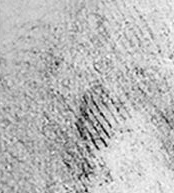 |
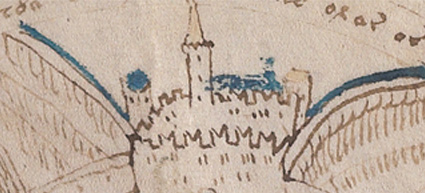 |
| Leonardo da Vinci’s hatching | Rosetta folio hatching |
Even right and left-hand margins: The right-hand margin of the script in Leonardo’s notebooks is always even, presumably achieved by writing up to the margin and if necessary, completing a word on the next line. When I examined parchment manuscripts from the 15th century (only those available on the internet), I found that manuscripts of block printed books have even right-hand margins while those written free hand generally did not. The VM’s script was treated exactly the same way as the script in Leonardo’s notebooks, the author wrote as far as the right-hand margin and continued the word on the next line. As a result single letters/symbols occur at some of the right and left-handed margins.
Plate 4 |
|
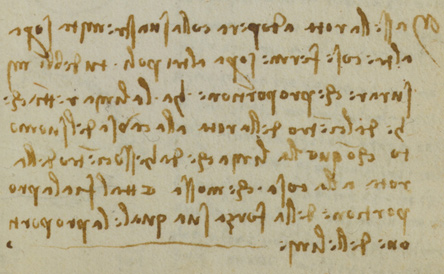 |
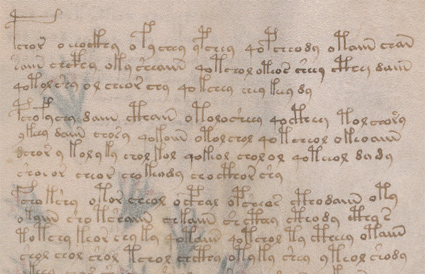 |
| Leonardo da Vinci’s Forster Codex, vol II pg 94r | Voynich Manuscript, folio 16r |
Dante’s Italian dialect and alphabet: Leonardo regarded himself as ‘a man without letters’, his notebooks use the same Tuscan dialect as Dante’s Divine Comedy. Leonardo’s notebooks were therefore written using the same 21 letter alphabet as Dante and excluded the letters j, k, w, x and y. You will find an ‘x’ similar to the letter ‘x’ in his notebooks, which represents an abbreviation for ‘ver’.(xii) He sometimes used a ‘j’ without a dot in place of an ‘i’. In his drawings he included the letters k, x, and y. This extended 21 letter alphabet and the use of numbers in his figures enabled him to identify parts of the figure with the corresponding text.(xiii) I used Florio’s 1611 Italian dictionary(xiv) that excludes the letters j, k, w, x, and y, to decode the anagram names of 111 of the VM’s plants.(xv) The VM uses the same Italian dialect and 21 letter alphabet as Dante, who is credited with standardizing the grammar and core lexicon of Florence and Tuscany which later became the basis for the official language of Italy: Plate 5, Plate 6, and Plate 7.
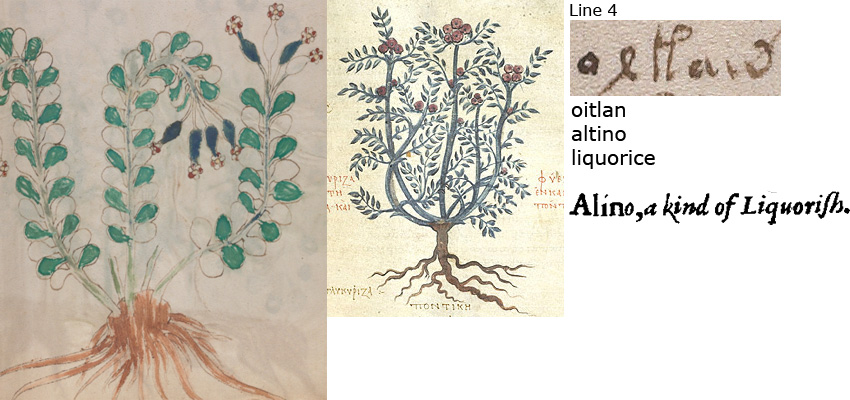


Paragraphs, capital letters and punctuation: Leonardo’s notebooks show ‘no punctuation whatever to regulate the division and construction of sentences,’ and no capital letters to indicate the beginning of a new sentence or the end of an old one.(xvi) The VM is written using its own unique alphabet and many of the letters are represented by symbols. It has neither punctuation marks, nor capital letters, nor full stops to terminate sentences.
Phonetic spelling: Leonardo’s lack of a formal education is reflected by his chaotic spelling, which far exceeded the irregularities of his day.(xvii) Richter stated that when he translated the text from Leonardo’s notebooks, words were often spelt phonetically. Some of the Voynich botanical plant names I decoded(xviii) matched the spelling of the name from Florio’s 1611 dictionary, while the spelling of others only matched phonetically: Plate 8 and Plate 9.
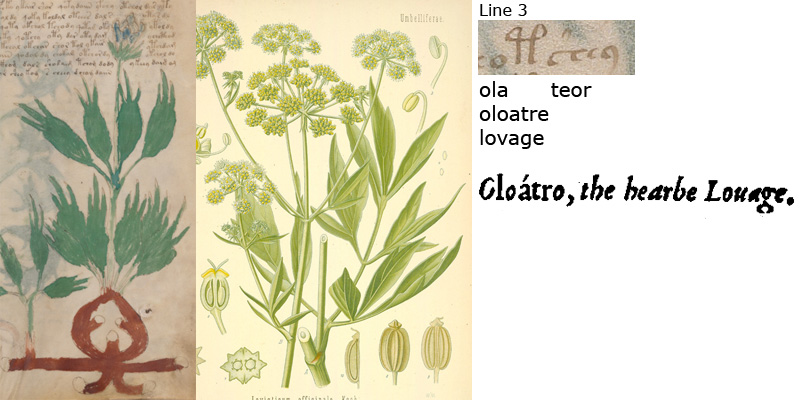
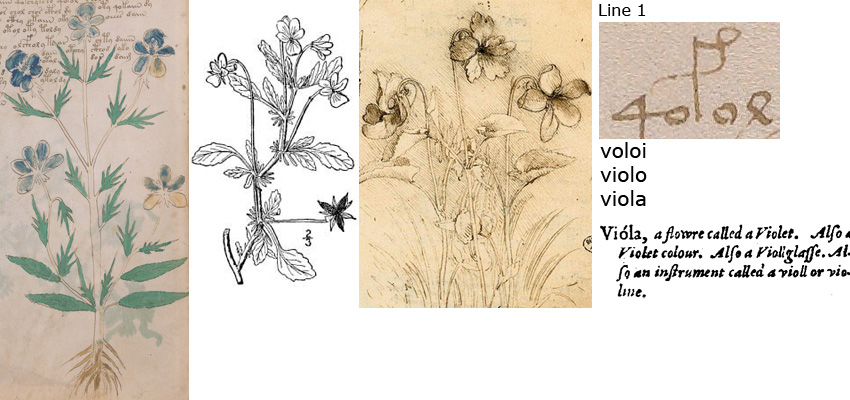
Combination of two or more words: Richter noted that one of the difficulties he encountered translating Leonardo’s notebooks was: ‘Leonardo made use of an orthography peculiar to himself; he had a fashion of amalgamating several short words into one long one, e.g. leforme, ditutti = le forme di tutti. Richter considered that ‘these combinations were intentional and indicated Leonardo’s desire of substituting a sort of phonetic writing for the rules in general use. His doubling of the letters as e.g. chessia for che sia and essella for e sel la’, Richter ‘believed was clear evidence of what may be called the orthography of Leonardo da Vinci’.(xix) The anagrams used to decode the names of some of the botanical plants(xx) included, in addition to the plant’s name, a preposition, conjunction, definite or indefinite article, i.e. a combination of two or three words or anagrams into one longer word or anagram:(xxi) Plate 10, Plate 11, and Plate 12.
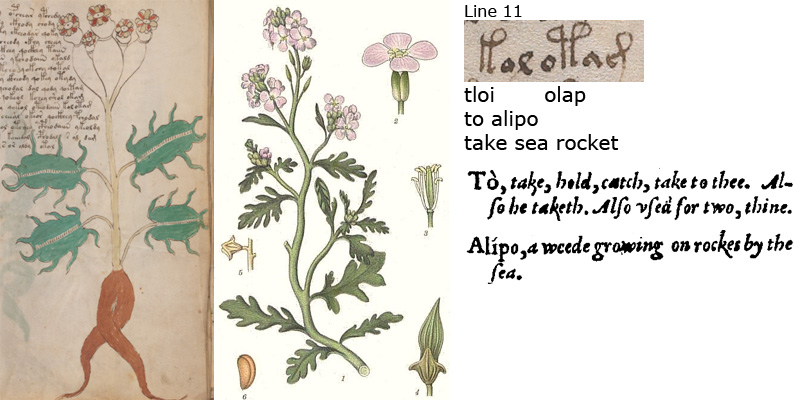
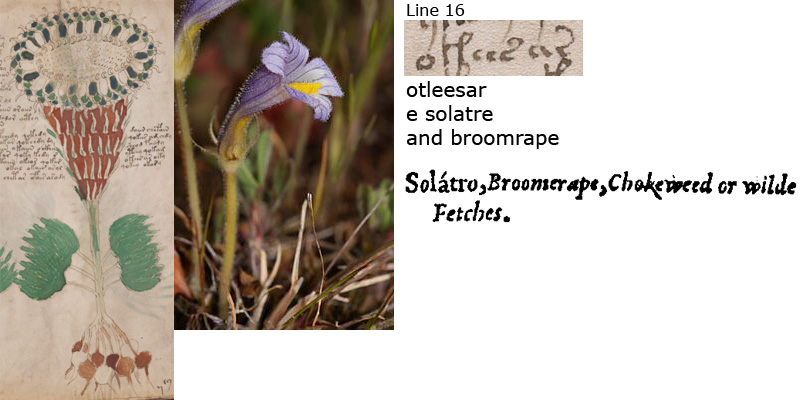
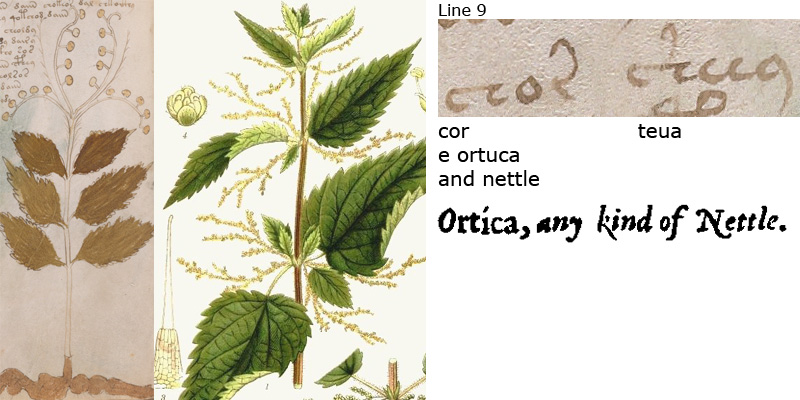
Longer words split into two or more short words: Another orthographic peculiarity of Leonardo’s writing was ‘that he would quite arbitrarily divide a long word into two separate halves.(xxii) These orthographic peculiarities are not found in the writings of other 15th century Italian authors.(xxiii) In the Voynich Manuscript some longer plant names were split into two or three consecutive words or anagrams: Plate 13, Plate 14, and Plate 15.
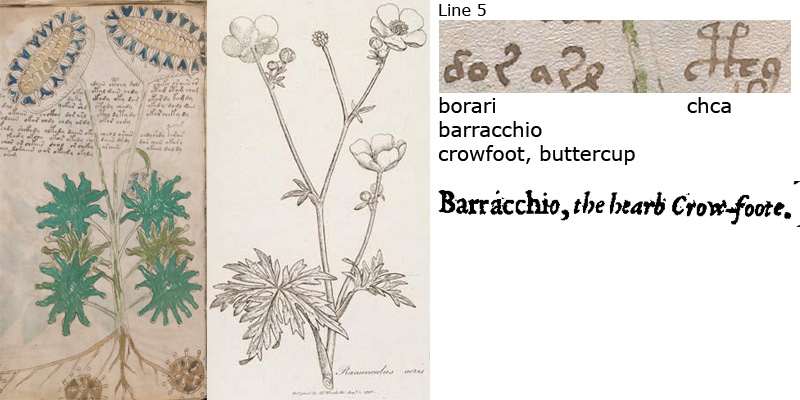

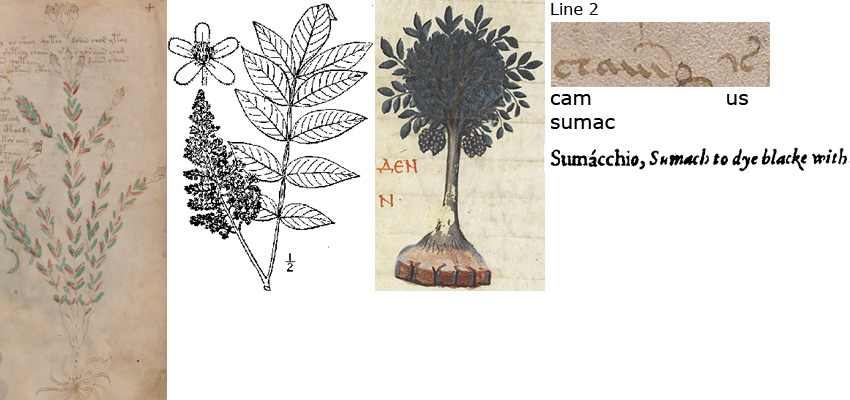
An ‘encyclopedic work on natural philosophy’: Leonardo was not only one of the world’s greatest painters and draftsmen, but his intellect and understanding of the physical world was centuries ahead of his time. Wilfred Voynich’s impression of the VM was that: ‘the drawings indicate it to be an encyclopedia work on natural philosophy,’(xxiv) the type of manuscript a young Leonardo may have written.
Birthday: Leonardo’s grandfather recorded in his diary that Leonardo was born at 3 hours after vespers (sunset), which on that day in Italy in 1452, was at 6.40 pm, i.e. he was born at 9.40.pm on the 15th of April 1452. The astrological drawing, folio 70v1, represents the zodiac sign for Aries.(xxv) This drawing shows three concentric circles of writing. In the center is a drawing of a ram, with the word Abril written beneath it. Within the circles are two circles of nude ladies sitting in tubs of water, 5 in the inner circle and 10 in the outer circle, a total of 15 ladies. Most of the ladies appear to be pregnant. The lady in the inner circle, at about the 10 o’clock position is standing up holding a striped string with a star. She is no longer pregnant and if you look closely you will see a baby under her arm. This drawing when viewed from a distance or reduced in size, resembles the face of a clock with a hand at about 9:40 am or pm. There is little doubt that this folio was intended to document a birth that occurred on the 15th of April around 10 am or pm. Folio 70v1, is consistent with Leonardo’s date, time of birth and zodiac sign: Plate 16.
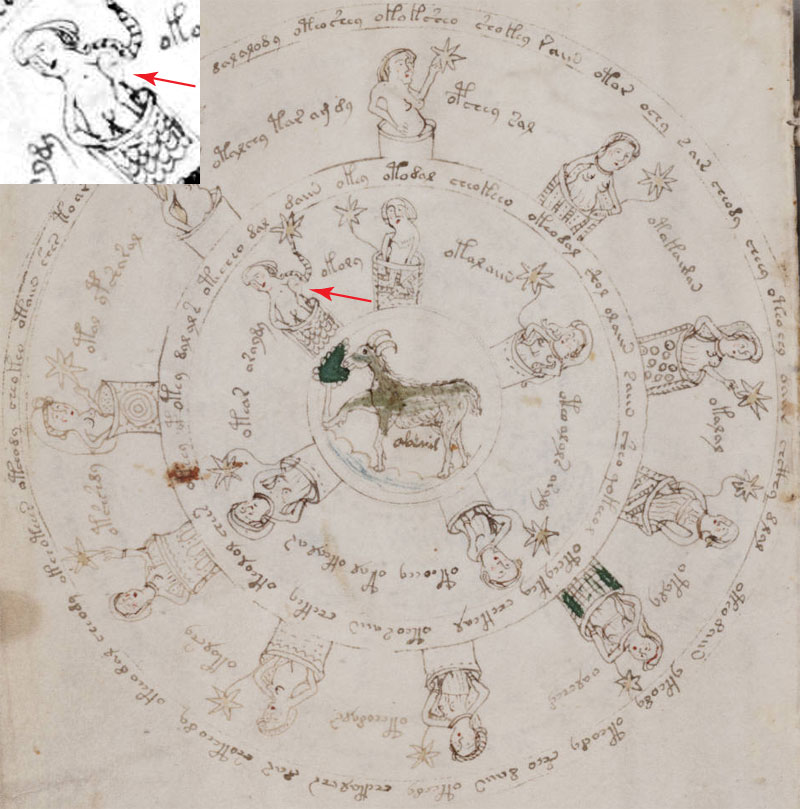
Conclusion: The above discussion shows that Dante’s Italian dialect was the language used by both Leonardo and the author of the VM. They have identical birthdays, similar left-handed hatching and script with even left and right margins without capital letters or punctuation, many words spelt phonetically and the same unique orthographical writing style. These similarities establish that Leonardo da Vinci is the author of this most mysterious manuscript, known as the Voynich Manuscript, a private diary he wrote during his youth to record his observations in the plants in his grandfather’s garden, herbal plants and recipes, human reproduction, astrology and astronomy. As Wilfred Voynich noted, the manuscript is an ‘encyclopedic work on natural philosophy.’(xxvi) Leonardo da Vinci was probably the auther of the Voynich Manuscript.

Acknowledgements: I wish to thank Robert Ward for suggesting that I investigate which Italian dialect Leonardo da Vinci used when he wrote his notebooks. This has enabled me to provide essentially irrefutable evidence that Leonardo wrote the Voynich Manuscript. As always I want to thank my daughter Erica for taking time from her busy schedule to put this article up on the Internet and a valued cousin for giving me the drawing below of Leonardo da Vinci. Finally I wish to thank the Beneicke Library, for providing a copy of the VM on the internet.
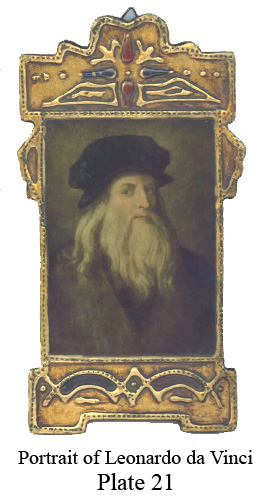
- ↑ back The Most Mysterious Manuscript, edited by Robert S. Brumbaugh, Southern Illinois University Press, 1978, p 117.
- ↑ back Name of Italy, Wikipedia https://en.wikipedia.org/wiki/Name_of_Italy
- ↑ back Edith Sherwood, The Carbon Dating of the Voynich Manuscript, http://www.edithsherwood.com/radiocarbon_dating_statistics_part3/index.php
- ↑ back Edith Sherwood, The Handwriting of Leonardo da Vinci and the Voynich Manuscript, http://www.edithsherwood.com/voynich-handwriting/index.php
- ↑ back J.P. Richter, The Notebooks of Leonardo da Vinci, vol I, Dover Publications , Inc., New York, 1970, xiii.
- ↑ back Edith Sherwood, The Voynich Manuscript’s Script and Code’, http://www.edithsherwood.com/voynich-script-and-code/index.php
- ↑ back Letter formation charts http://www.hwtears.com/files/Letter%20Formation%20Charts.pdf
- ↑ back Varieties of left hand writing http://www.musanim.com/mam/lefthand.htm
- ↑ back Edith Sherwood, The Voynich Manuscript, Full Circle, http://www.edithsherwood.com/voynich_full_circle/index.php
- ↑ back J.P. Richter, The Notebooks of Leonardo da Vinci, vol I, Dover Publications , Inc., New York, 1970, p. 8.
- ↑ back Edith Sherwood, The Voynich Manuscript: Is the Author Left Handed? http://www.edithsherwood.com/voynich_author/index.php
- ↑ back J.P. Richter, The Notebooks of Leonardo da Vinci, vol I, Dover Publications , Inc., New York, 1970, p. 1-4.
- ↑ back J.P. Richter, The Notebooks of Leonardo da Vinci, vol I, Dover Publications , Inc., New York, 1970, p. 1-4.
- ↑ back Florio’s 1611 Italian English Dictionary, http://www.pbm.com/~lindahl/florio/
- ↑ back Edith Sherwood, The Voynich Botanical Plant Names Decoded. http://www.edithsherwood.com/voynich-botanical-plant-anagrams/index.php
- ↑ back J.P. Richter, The notebooks of Leonardo da Vinci, vol. I, Dover Publications, Inc., New York, 1970, p. 2.
- ↑ back Giorgio Santillana, in Leonardo da Vinci, Aspects of the Renaissannce genius, ed. M. Phillipson, George Braziller, New York, 1966, p. 191.
- ↑ back Edith Sherwood, The Voynich Botanical Plant Names Decoded. Ibid.
- ↑ back J.P. Richter, The notebooks of Leonardo da Vinci, vol. I, Dover Publications, Inc., New York, 1970, p. 2.
- ↑ back Edith Sherwood, The Voynich Botanical Plant Names Decoded. Ibid.
- ↑ back Edith Sherwood, The Voynich Botanical Plant Names Decoded. Ibid.
- ↑ back J.P. Richter, The notebooks of Leonardo da Vinci, vol. I, Dover Publications, Inc., New York, 1970, p. xiv.
- ↑ back J.P. Richter, The notebooks of Leonardo da Vinci, vol. I, Dover Publications, Inc., New York, 1970, p. xiv.
- ↑ back M.E. D’Imperio, The Voynich Manuscript, An Elegant Enigma, Aegeon Park Press, p. 22.
- ↑ back Edith Sherwood, Leonardo da Vinci and the Voynich Manuscript, http://www.edithsherwood.com/voynich_author_da_vinci/index.php
- ↑ back M.E. D’Imperio, The Voynich Manuscript, An Elegant Enigma, Aegeon Park Press, p. 22.